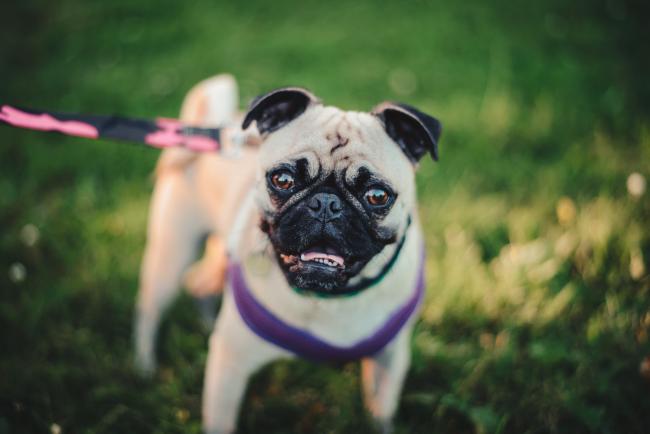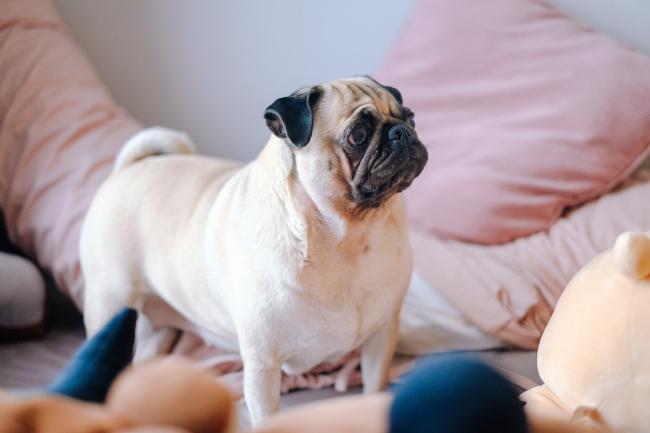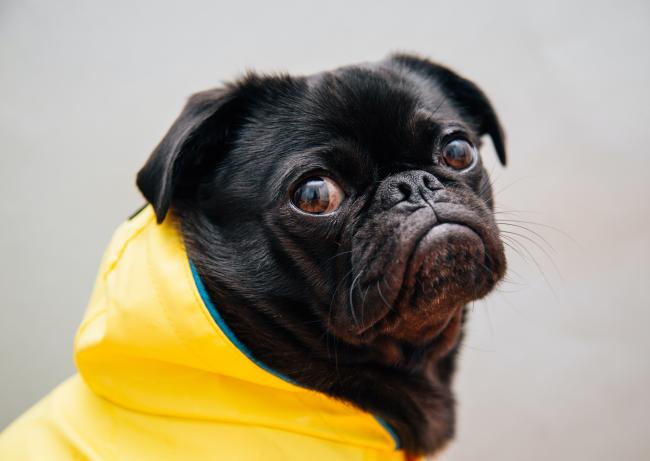Pug: Breed Information

Fact sheet
- Breed name: Pug
- Classification: Toy / Companion dog
- Size: small
- Coat: short and smooth
- Colour: Grey/apricot with black face and ears, black
- Personality: affectionate, playful
- Family-friendly: yes
- Friendly with other pets: yes
Pug Background
Pugs are cute little dogs with ancient origins dating all the way back to the Tibetan Mastiff breed in China. In fact, ancient terracotta sculptures of pug-like dogs can be found as early as the Han Dynasty. The breed was adored by mighty Emporers and nobility alike.
The Dutch East India Company began trading with China and introduced pugs to Europe around the 16th Century. Unsurprisingly, this dignified little dog was a favourite among European royalty for their loyalty and companionship. Queen Victoria, Marie Antoinette and Napolean Bonaparte’s wife Josephine Bonaparte were a just few such famous pug-fans in their time. Pugs can be spotted in prized works of European art on gallery walls to this day.
Physical Appearance of the Pug
Pugs are small, stocky dogs with a round head, floppy ears, a curled tail and a distinctive flat muzzle. The face of a pug is hard to forget, with a wrinkled forehead and pleading, protruding eyes. Despite their cute expression, care must be taken to prevent eye injury due to their bulging shape.
The breed’s colouring can vary from apricot or grey with a black face and ears, or all black. All pugs have short coats that have a tendency to shed. They can weigh anywhere between 9 kg and stand up to 35 cm tall.
Pug Behaviour and Temperament
Pugs, in a nutshell, love to cuddle. They have been kept as companion dogs for centuries and certainly know it!
As such, expect your pug to love nothing more than to sit on your lap and spend time with you on the couch. Notably, as affectionate companions, pugs don’t love being left alone during the day. Therefore, it’s important to consider your daily routine if you are looking to adopt a pug.
Although pugs are excellent lap dogs, they still love to play, cause mischief and have fun. However, note that they adore food and need regular exercise to keep their weight in check.

Training and Exercising Pugs
Pugs need daily exercise to keep healthy and fit, but be super careful to avoid very hot or humid weather. This breed does not adjust well in extreme temperatures and is best kept inside from the elements to avoid serious illness. Likewise, they can experience some respiratory issues due to their short muzzle. Go easy on exercise and stop if your pug is wheezy.
Pugs can be a little stubborn during obedience and house training, so it's important to be patient and consistent. They are, however, intelligent dogs that will get there in their own time. Set your pug up for success by taking them to puppy preschool.
Living with a Pug
Pugs are ideal dogs for small home spaces, due to their compact size and easygoing attitude. It’s important, however, to give your pug plenty of company and attention, as they don’t enjoy being left alone for long periods. Your pug will also need daily exercise to stay healthy. A walk around the block or game of fetch will do the trick but pull it right back if you notice them start to struggle or wheeze.
Pugs are generally easy-going and friendly with other humans and pets and benefit from early socialisation. Compared to other companion dog breeds, pugs aren't super yappy. However, pugs snore, so they aren't a breed for light sleepers!

Pug Health
Pugs are resilient little dogs that can live to the ripe old age of 15. However, they have some notable health issues that you need to keep an eye out for.
It’s important to monitor your pug’s weight to avoid obesity and the many problems that can result from this. Likewise, pugs can experience respiratory problems and become very unwell in humid or hot weather. Keep them indoors and avoid exercise on extreme days.
Some major health concerns in pugs include:
- Pug Dog Encephalitis - speak with your vet, and look out for symptoms such as trembling, seizures, fever, paralysis or any major changes in behaviour.
- Epilepsy
- Eye problems such as dry eye
- Skin problems and allergies
- Respiratory problems such as stenotic nares
- Hip Dysplasia
- Patellar Luxation
Speak with your vet about these health issues and, as always, only approach reputable breeders if you are adopting a pug. Your vet will be able to give you advice if you adopt from a shelter.
Grooming
Pugs shed a surprising amount of fur and need regular brushing with a short-haired brush. They shouldn’t need bathing too often, however, it’s absolutely essential to give their skin folds a gentle wipe on a regular basis to avoid infection. Make sure they are fully dry after bathing or splashing in puddles and wipe them gently with a cotton bud or cloth, taking care around the eyes. If you notice any weeping or sore spots, go straight to your vet.
Lastly, as with many little dog breeds, Pugs can have dental issues. Therefore, keep their teeth clean using a dog toothbrush and doggy toothpaste.
Does your pug need cuddles during the day when you aren’t home? A Pawshake pet sitter can help. Start searching for a friendly sitter today.






